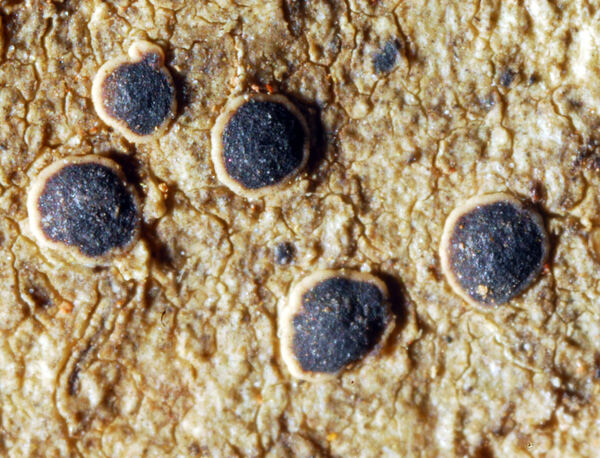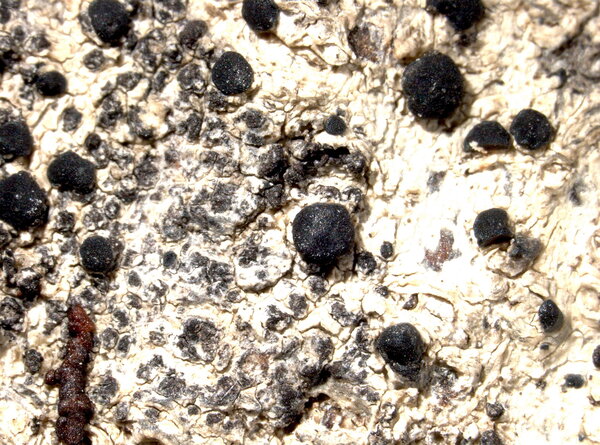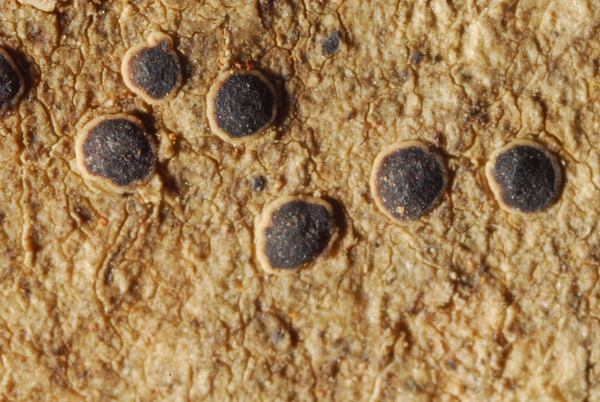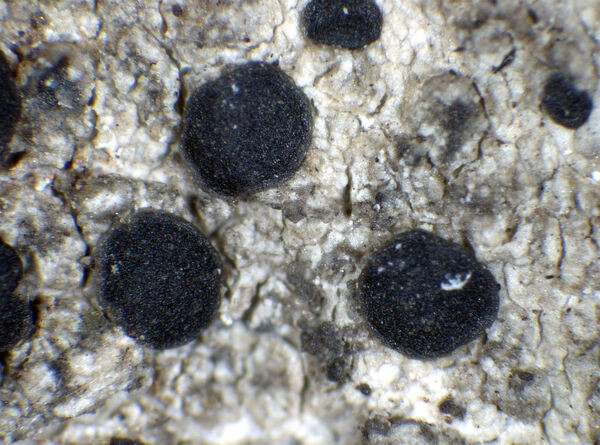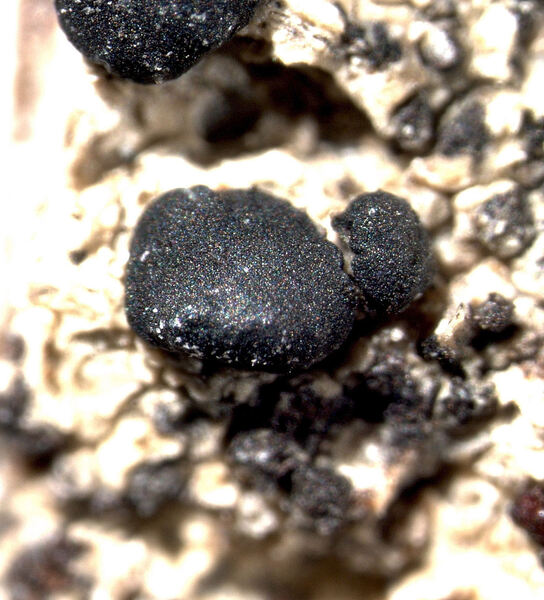Megalaria laureri (Th. Fr.) Hafellner
in Nimis, The Lichens of Italy: 429, 1993. Basionym: Catillaria laureri Hepp ex Th. Fr. - Lichenogr. Scand., 2: 582, 1874.
Synonyms: Biatorina intermixta auct.; Catillaria intermixta auct. non (Nyl.) Arnold ex Glow.; Catinaria intermixta auct. non (Nyl.) P. James; Catinaria laureri (Th. Fr.) Degel.; Gyalecta livida (Mudd) Zahlbr.; Phialopsis livida Mudd
Description: Thallus crustose, thinly episubstratic, smooth to unevenly warted or finely granulose, whitish grey, ecorticate, often delimited by a black prothallus. Apothecia lecideine, 0.4-1.2 mm across, strongly constricted to subpedicellate, with a flat to convex, black or rarely brown-black, epruinose disc and a usually paler, grey-black, matt, persistent, sometimes finally excluded proper margin. Proper exciple 60-80 μm thick laterally, of radiating, branched and anastomosing, conglutinated hyphae, grey-green to blackish green and N+ purple-red along the outer edge, pale to deep purple-pink and N+ pale orange within, extending below the hypothecium; epithecium patchily blackish green and purple-brown, K+ reddish violet, c. 20 µm high; hymenium colourless or partly pale reddish brown, (50-)65-75(-80) μm high, not inspersed with oil droplets, I+ pale blue; paraphyses lax in K, mostly simple, 1-2 μm thick at mid-level, the apical cells 4-5 μm wide; hypothecium 40-100 μm high, not inspersed with oil droplets, the upper part purple-brown to purple-pink, K+ reddish violet, N+ pale orange, the lower part greenish grey, N+ purple-red. Asci 8-spored, clavate to cylindrical-clavate, the apical dome K/I+ dark blue with a pale, conical-pointed apical cushion (axial mass) never penetrating through the entire d-layer, the wall K/I-, but the thin outer gel K/I+ blue, Bacidia-type. Ascospores 1-septate, hyaline, ellipsoid to ovoid, 12-18(-24) x 5-8 μm. Photobiont chlorococcoid, the cells 6-14 μm wide. Spot tests: thallus K- or K+ pale yellow, C-, KC-, P-. Chemistry: thallus without lichen substances, or with low amounts of atranorin.
Growth form: Crustose
Substrata: bark
Photobiont: Trentepohlia
Reproductive strategy: mainly sexual
Most common in areas with a humid-warm climate (e.g. most of Tyrrenian Italy)
Commonnes-rarity: (info)
Alpine belt: absent
Subalpine belt: absent
Montane belt: extremely rare
Dry submediterranean belt: extremely rare
Humid submediterranean belt: extremely rare
Padanian area: absent
pH of the substrata:
1 2 3 4 5
Solar irradiation:
1 2 3 4 5
Aridity:
1 2 3 4 5
Eutrophication:
1 2 3 4 5
Poleotolerance:
0 1 2 3
Altitudinal distribution:
1 2 3 4 5 6
Rarity
absent
extremely rare
very rare
rare
rather rare
rather common
common
very common
extremely common
Loading data...
Occurrence data
Predictive map
Growth form: Crustose
Substrata: bark
Photobiont: Trentepohlia
Reproductive strategy: mainly sexual
Most common in areas with a humid-warm climate (e.g. most of Tyrrenian Italy)
Commonnes-rarity: (info)
Alpine belt: absent
Subalpine belt: absent
Montane belt: extremely rare
Dry submediterranean belt: extremely rare
Humid submediterranean belt: extremely rare
Padanian area: absent
pH of the substrata:
| 1 | 2 | 3 | 4 | 5 |
Solar irradiation:
| 1 | 2 | 3 | 4 | 5 |
Aridity:
| 1 | 2 | 3 | 4 | 5 |
Eutrophication:
| 1 | 2 | 3 | 4 | 5 |
Poleotolerance:
| 0 | 1 | 2 | 3 |
Altitudinal distribution:
| 1 | 2 | 3 | 4 | 5 | 6 |
Rarity
absent
extremely rare
very rare
rare
rather rare
rather common
common
very common
extremely common
Loading data...
Occurrence data
Predictive map


